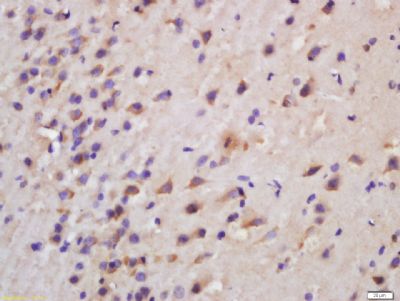Ceramide synthase 1 Polyclonal Antibody
Purified Rabbit Polyclonal Antibody (Pab)
- 产品详情
- 实验流程
Application
| WB, IHC-P, IHC-F, IF, E |
|---|---|
| Primary Accession | P27544 |
| Reactivity | Rat, Pig, Dog, Bovine |
| Host | Rabbit |
| Clonality | Polyclonal |
| Calculated MW | 39536 Da |
| Physical State | Liquid |
| Immunogen | KLH conjugated synthetic peptide derived from human LASS1 |
| Epitope Specificity | 181-280/350 |
| Isotype | IgG |
| Purity | affinity purified by Protein A |
| Buffer | 0.01M TBS (pH7.4) with 1% BSA, 0.02% Proclin300 and 50% Glycerol. |
| SUBCELLULAR LOCATION | Endoplasmic reticulum membrane; Multi-pass membrane protein. Isoform 1: Endoplasmic reticulum membrane; Multi-pass membrane protein. Golgi apparatus membrane; Multi-pass membrane protein. Note=Isoform 1 may recycle from the Golgi to the endoplasmic reticulum. |
| SIMILARITY | Contains 1 TLC (TRAM/LAG1/CLN8) domain. |
| Important Note | This product as supplied is intended for research use only, not for use in human, therapeutic or diagnostic applications. |
| Background Descriptions | LASS1 may be either a bona fide (dihydro)ceramide synthase or a modulator of its activity. When overexpressed in cells it is involved in the production of sphingolipids containing mainly one fatty acid donnor in a fumonisin B1-independent manner. |
| Gene ID | 10715 |
|---|---|
| Other Names | Ceramide synthase 1, CerS1, 2.3.1.-, LAG1 longevity assurance homolog 1, Longevity assurance gene 1 protein homolog 1, Protein UOG-1, CERS1 {ECO:0000303|PubMed:17977534, ECO:0000312|HGNC:HGNC:14253} |
| Dilution | WB=1:500-2000,IHC-P=1:100-500,IHC-F=1:100-500,IF=1:100-500,ELISA=1:5000-10000 |
| Format | 0.01M TBS(pH7.4) with 1% BSA, 0.09% (W/V) sodium azide and 50% Glyce |
| Storage | Store at -20 °C for one year. Avoid repeated freeze/thaw cycles. When reconstituted in sterile pH 7.4 0.01M PBS or diluent of antibody the antibody is stable for at least two weeks at 2-4 °C. |
| Name | CERS1 {ECO:0000303|PubMed:17977534, ECO:0000312|HGNC:HGNC:14253} |
|---|---|
| Function | Ceramide synthase that catalyzes the transfer of the acyl chain from acyl-CoA to a sphingoid base, with high selectivity toward stearoyl-CoA (octadecanoyl-CoA; C18:0-CoA) (PubMed:17977534, PubMed:23530041, PubMed:26887952, PubMed:31916624). N-acylates sphinganine and sphingosine bases to form dihydroceramides and ceramides in de novo synthesis and salvage pathways, respectively (PubMed:17977534, PubMed:23530041, PubMed:24782409, PubMed:26887952, PubMed:31916624). Plays a predominant role in skeletal muscle in regulating C18 ceramide and dihydroceramide levels with an impact on whole-body glucose metabolism and insulin sensitivity. Protects from diet-induced obesity by suppressing the uptake of glucose in multiple organs in a FGF21-dependent way (By similarity). Generates C18 ceramides in the brain, playing a critical role in cerebellar development and Purkinje cell function (By similarity). In response to cellular stress mediates mitophagy, a known defense mechanism against cell transformation and aging. Upon mitochondria fission, generates C18 ceramides that anchor lipidated MAP1LC3B/LC3B-II autophagolysosomes to outer mitochondrial membranes to eliminate damaged mitochondria (PubMed:22922758). |
| Cellular Location | Endoplasmic reticulum membrane; Multi-pass membrane protein |
Research Areas
For Research Use Only. Not For Use In Diagnostic Procedures.
Application Protocols
Provided below are standard protocols that you may find useful for product applications.
终于等到您。ABCEPTA(百远生物)抗体产品。
点击下方“我要评价 ”按钮提交您的反馈信息,您的反馈和评价是我们最宝贵的财富之一,
我们将在1-3个工作日内处理您的反馈信息。
如有疑问,联系:0512-88856768 tech-china@abcepta.com.
¥ 1,500.00
Cat# AP58273























 癌症的基本特征包括细胞增殖、血管生成、迁移、凋亡逃避机制和细胞永生等。找到癌症发生过程中这些通路的关键标记物和对应的抗体用于检测至关重要。
癌症的基本特征包括细胞增殖、血管生成、迁移、凋亡逃避机制和细胞永生等。找到癌症发生过程中这些通路的关键标记物和对应的抗体用于检测至关重要。 为您推荐一个泛素化位点预测神器——泛素化分析工具,可以为您的蛋白的泛素化位点作出预测和评分。
为您推荐一个泛素化位点预测神器——泛素化分析工具,可以为您的蛋白的泛素化位点作出预测和评分。 细胞自噬受体图形绘图工具为你的蛋白的细胞受体结合位点作出预测和评分,识别结合到自噬通路中的蛋白是非常重要的,便于让我们理解自噬在正常生理、病理过程中的作用,如发育、细胞分化、神经退化性疾病、压力条件下、感染和癌症。
细胞自噬受体图形绘图工具为你的蛋白的细胞受体结合位点作出预测和评分,识别结合到自噬通路中的蛋白是非常重要的,便于让我们理解自噬在正常生理、病理过程中的作用,如发育、细胞分化、神经退化性疾病、压力条件下、感染和癌症。






